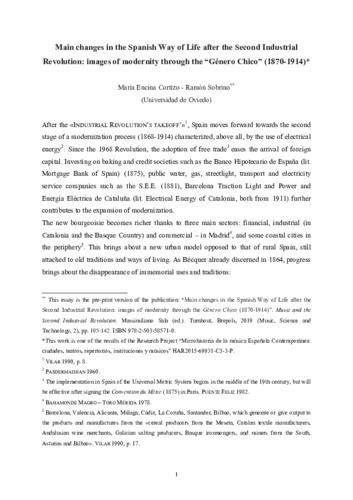Main changes in the Spanish Way of Life after the Second Industrial Revolution: images of modernity through the Género Chico (1870-1914)
Autor(es) y otros:
Palabra(s) clave:
Musicología
Revolución industrial
Música española
Siglo XIX
Género Chico
Modernidad tecnológica
Fecha de publicación:
Editorial:
Massimiliano Sala
Citación:
Serie:
Music, Science and Technology, 2;
Descripción física:
Resumen:
After the «INDUSTRIAL REVOLUTION’S TAKEOFF’» , Spain moves forward towards the second stage of a modernization process (1868-1914) characterized, above all, by the use of electrical energy . Since the 1968 Revolution, the adoption of free trade eases the arrival of foreign capital. Investing on baking and credit societies such as the Banco Hipotecario de España (lit. Mortgage Bank of Spain) (1875), public water, gas, streetlight, transport and electricity service companies such as the S.E.E. (1881), Barcelona Traction Light and Power and Energía Eléctrica de Cataluña (lit. Electrical Energy of Catalonia, both from 1911) further contributes to the expansion of modernization. The new bourgeoisie becomes richer thanks to three main sectors: financial, industrial (in Catalonia and the Basque Country) and commercial – in Madrid , and some coastal cities in the periphery . This brings about a new urban model opposed to that of rural Spain, still attached to old traditions and ways of living. As the word flies through the telegraphic thread, the railway expands, the industry grows, the cosmopolitan spirit of civilization invades our country, its characteristic features, its immemorial traditions, its picturesque garments and its old-fashioned ideas go away with it . Such quick modernization will end up sinking us in a deep identity crisis after the loss of the last colonies in 1898, as is evinced by the dialectics between tradition and modernity. In this work, we will approach the image of modernity as shown in the texts of lyric theatre during the second industrial revolution, approximately between 1868 and 1914, through the appearance of the stories in the texts of some of the most determining factors: the railway, electricity, and other means of transport and inventions that radically transformed life, leading it to modernity.
After the «INDUSTRIAL REVOLUTION’S TAKEOFF’» , Spain moves forward towards the second stage of a modernization process (1868-1914) characterized, above all, by the use of electrical energy . Since the 1968 Revolution, the adoption of free trade eases the arrival of foreign capital. Investing on baking and credit societies such as the Banco Hipotecario de España (lit. Mortgage Bank of Spain) (1875), public water, gas, streetlight, transport and electricity service companies such as the S.E.E. (1881), Barcelona Traction Light and Power and Energía Eléctrica de Cataluña (lit. Electrical Energy of Catalonia, both from 1911) further contributes to the expansion of modernization. The new bourgeoisie becomes richer thanks to three main sectors: financial, industrial (in Catalonia and the Basque Country) and commercial – in Madrid , and some coastal cities in the periphery . This brings about a new urban model opposed to that of rural Spain, still attached to old traditions and ways of living. As the word flies through the telegraphic thread, the railway expands, the industry grows, the cosmopolitan spirit of civilization invades our country, its characteristic features, its immemorial traditions, its picturesque garments and its old-fashioned ideas go away with it . Such quick modernization will end up sinking us in a deep identity crisis after the loss of the last colonies in 1898, as is evinced by the dialectics between tradition and modernity. In this work, we will approach the image of modernity as shown in the texts of lyric theatre during the second industrial revolution, approximately between 1868 and 1914, through the appearance of the stories in the texts of some of the most determining factors: the railway, electricity, and other means of transport and inventions that radically transformed life, leading it to modernity.
ISBN:
Patrocinado por:
Proyecto de investigación del Plan Nacional “Microhistoria de la música Española Contemporánea: ciudades, teatros, repertorios, instituciones y músicos” HAR2015-69931-C3-3-P.
Colecciones
- Capítulos de libros [6536]
- Historia del Arte y Musicología [500]
- Investigaciones y Documentos OpenAIRE [8421]
Ficheros en el ítem




